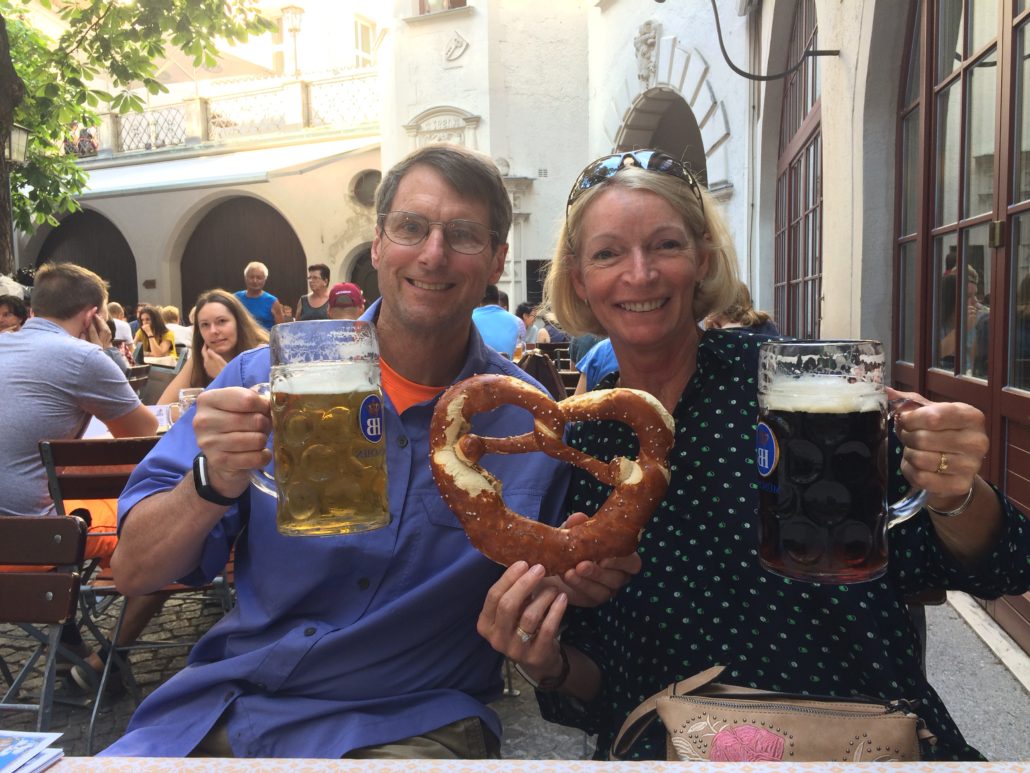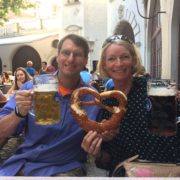Retirement Planning Done Well.

Dola Handley and Cary Smith in Munich, Germany
Imagine with me that you are working 60 hour weeks, making life-and-death decisions virtually every day, herding cats that are your staff, fighting with superiors for adequate resources, putting up with arrogant personalities, being on call-standby many weekends and operating on less than adequate sleep.
Now imagine that you’ve been doing most or all of the above for 20+ years.
Imagine further that you finally decided you’ve had enough and jumped off the cliff into retirement.
If I then asked you the questions: “How do you come down from that type of intense existence?” “How does it feel?” – what do you think your response might be?
I posed those very questions to a recently retired nurse executive that I had connected with on LinkedIn.
Her name is Dola Handley.
I pushed for a phone conversation with her because I was curious, as part of my overall research into the retirement mindset, why she retired, what the experience has been like for her and what she sees ahead for her and her husband.
In my 17 years as a healthcare recruiter, a high percentage of the hundreds of conversations I’ve had with candidates have been with middle- and executive-level nurses like Dola. Bachelor- or master-degreed RN’s, some even with doctorates.
Dola fits the mold of this very special breed of professionals. Selfless; humbling in the depth of their commitments to care; overworked, underpaid and (colossally) under-appreciated in their work environment.
Dola has “completed” her 22- year nursing career which included 20 years of active military duty with over half of that in a tactical signal officer role then as a nurse and a number of Director-level management positions in large hospitals overseeing women’s services/mother-baby/OB units.
I found her answers to those questions to be insightful:
- “How do you come down from that type of intense existence?” Answer: I’m experiencing “active stillness”.
- “How does it feel?” Answer: I’m “wonderfully bored”.
I probed both responses.
“Active stillness” for Dola is a throwback to her Appalachian farm upbringing where there was a lot of downtime and one learned to “relax into non-stressful activity but staying active” For her, that currently includes satisfying her love of the outdoors by doing volunteer outdoor work with the state parks department here in Colorado. She also walks 3-4 miles a day with a friend. She likes to mentor and finds that people she worked with are calling her for advice which she unselfishly provides. She also meets monthly with a group of five nurses on a social basis where, not surprisingly, she has become the de-facto leader.
Also, in typical nurse fashion, she couldn’t turn aside a request to do some voluntary consulting work for a local hospital that was setting up a new mother/baby unit. She got that out of her system – it was a good reminder of why she had retired.
Being “wonderfully bored” means she no longer needs to dread the ringing phone, the pressure of someone in a health crisis, the weekend on-call inconvenience and, most of all, the 12-hour days.
Her work “filled her up” for years and she is proud that she impacted a lot of people.
She doesn’t miss it.
She is a doer, a server who is now freer and hasn’t lost anything. She revels in being able to now set her own schedule. She knows what is right for her and that includes peace every day, comfortable in being financially secure and not worrying about where she is mentally, emotionally, physically.
Dola is less than a year into her retirement so the bloom is still on the rose, so to speak. How will she feel, how will all of this play out say 1,2,3 years from now? That’s part of the adventure.
Something tells me that Dola will somehow just go deeper and wider in her active stillness and stay wonderfully bored but busier in her service to others. I’m suggesting that because, if I may paraphrase, you can take the nurse out of nursing but you can’t take the nurse out of a nurse.

Oh, did you catch the financially secure part?
I wonder how many couples start serious retirement planning discussions ten years before their targeted retirement date.
I believe one would need to sort through a trainload of couples to find one or two.
Dola and her husband, Cary Smith, are married with a blended family of four grown daughters and would be one of those rare finds.
This couple doesn’t fit the mold in this area. They have their proverbial you-know-what together in this department.
Dola shared with me that she and Cary began retirement discussion together over 10 years ago. They are both planners. Cary, also a military retiree (they met in the military) is a skilled program manager still gainfully employed, by choice.
They both have military pensions and the accompanying health care coverage. She didn’t reveal what they have stashed away beyond that but what I did find unusual, impressive and prescient is what they have done with real estate as they have gone through a number of job changes and relocations.
Within the last decade, they have lived in four homes. Three of those (two in N. Carolina, one in Colorado) they have kept and are renting out, thus adding a nice equity component to the portfolio. The fourth is their current residence in Colorado Springs.
Cary is keying his retirement date to the day they write the last mortgage payment check for the house they are in – which is two years out.
The retirement discussions that began 10 years ago focused on:
- What they want to do.
- Where they want to do it.
- What they want this third stage to look like.
Listening to Dola, you’ll get the impression that the what, where and how are pretty well set. And the when is on the radar.
The initial “what” sounds exciting. They both have spent extended periods of time working abroad. They are doing a “pre-retirement” trip to Scotland next year and have agreed that, upon retirement, they will pick and move to a location (TBD), most likely in Europe, and go, “not as tourists”, for an extended stay.
And then determine the next step.

Dola and Cary present a stark contrast to the route most couples take to retirement, particularly on the non-financial side. Research has shown that 2 of 3 couples go into retirement without a semblance of a non-financial plan. As a Retirement Coach, I’m discovering that a surprising number of couples wait until the retirement of one or the other of the partnership to get on the same page, adjusting to the changed environment and sorting out what they want retirement life to look like.
It results in the loss of precious retirement years where resources and physical vitality are higher
It may help explain why the divorce rate of couples over 50 has been skyrocketing while overall divorce rates have leveled off.
The takeaway from Dora’s and Cary’s retirement story is clear: start early, agree on what you want it to look like, put a plan together but be flexible and willing to compromise and respect the interests and desire of the other.
Theirs may seem like a retirement heavily tilted to a “life of leisure”. I ‘spect not. I doubt this nurse and these two military veterans will ever give up an opportunity to continue to serve in some way.





Thanks for making their story available. It certainly creates lots of thoughts about the value of planning as we rethink our retirement with different perspectives into the future.
Thanks Jim. Glad you found value in the article. It was great reconnecting with you last week.
I believe you have observed some very interesting points, regards for the post.
I like what you guys are up too. Such smart work and reporting! Carry on the excellent works guys I have incorporated you guys to my blogroll. I think it will improve the value of my website :).